When your furnace keeps tripping the breaker, it's more than just a pain. It's a safety warning from your home. That little switch in your electrical panel is doing its job. It's telling you that something is pulling too much power.
It’s a frustrating problem, but it's also a clear sign that your furnace needs attention.
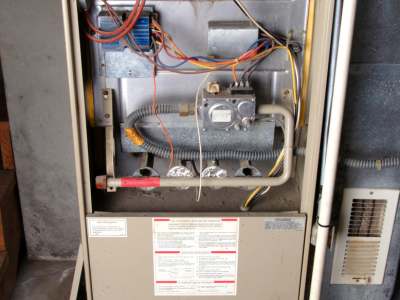
Why Your Furnace Trips the Breaker
It’s cold outside, and the last thing you want is for your furnace to stop working. When that circuit breaker trips, it's protecting your home from a dangerous electrical problem. Think of it as a safety switch that cuts the power before something bad, like a fire, can happen.
This isn't just a random glitch. It's a sign of a deeper issue. Your furnace is a complex machine, and several different problems can make it use too much electricity.
The Most Common Reasons
While there are many possible causes, a few common problems are usually to blame. Figuring out which one you have is the first step. The issue could be as simple as a dirty filter or as serious as a broken part.
Here are the most common reasons why your furnace trips its breaker:
- Blocked Airflow: This is the most frequent cause. A clogged, dirty air filter is the #1 reason. When air can't move freely, the furnace's fan motor has to work much harder. This makes it get too hot and pull more power than the circuit can handle.
- A Worn-Out Fan Motor: The motor itself might be old and failing. As its parts wear down, it needs more and more energy just to spin, which can overload the circuit.
- Electrical Problems: Frayed, damaged, or loose wires inside the furnace can create a short circuit. This is a serious problem that will trip the breaker right away to prevent a fire.
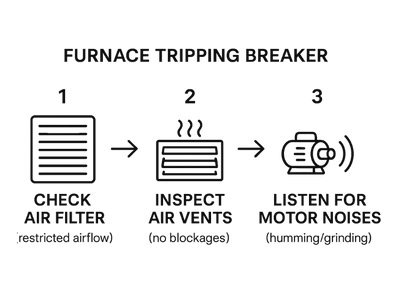 This picture walks you through the first few checks you can do yourself to find the problem. As you can see, it's smart to start with the simple
things, like the air filter and vents. Don't assume you have a big motor or electrical problem right away.
This picture walks you through the first few checks you can do yourself to find the problem. As you can see, it's smart to start with the simple
things, like the air filter and vents. Don't assume you have a big motor or electrical problem right away.
Common Causes for a Tripped Furnace Breaker
To give you a quick guide, here's a list of common causes and whether you can fix them yourself.| Problem Area | Simple Explanation | DIY Fix or Pro Help? |
|---|---|---|
| Dirty Air Filter | The filter is full of dust, making the fan motor work too hard and get too hot. | DIY Fix (Easy and cheap) |
| Blocked Vents | Closed or blocked vents in your home are stopping air from moving freely. | DIY Fix (Just open them!) |
| Failing Motor | The fan motor is old or broken, causing it to use too much electricity. | Pro Help (Needs an expert) |
| Short Circuit | Damaged wires are causing a dangerous electrical problem. | Pro Help (Very important for safety) |
| Shared Circuit | Other big appliances are plugged into the same circuit as the furnace, causing an overload. | DIY Fix (Move other plugs) |
This table doesn't cover everything, but it includes the most common problems we see. Always start with the easy DIY checks before calling a professional.
One of the top reasons a furnace trips the breaker is a stressed fan motor, which is almost always caused by a dirty filter. Thin 1-inch filters should be changed every 30 days. Thicker filters can last up to a year. Regular checks are the best way to stop your furnace from overheating and shutting down.
Easy DIY Checks You Can Do Safely
Before you worry about a huge repair bill, let’s go over the simple and safe things you can check yourself. When a furnace keeps tripping the breaker, the cause is often something you can find and fix in a few minutes with no special tools.
First, safety is key. Always turn off the power to your furnace at the breaker box before you touch anything. If you're not sure how, it's a good idea to learn how to reset a circuit breaker the right way. Once the power is off, you’re ready to look for the problem.
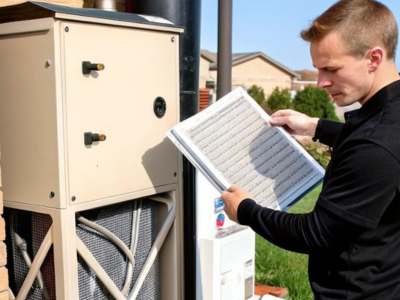
Check the Furnace Air Filter
The number one reason a furnace overloads a circuit is a clogged air filter. It’s a simple idea. Your furnace's fan is trying to pull air through a filter that’s packed with dust and dirt.
This makes the motor work way harder than it should, which pulls a lot more electricity. The circuit breaker sees this extra power as a fire risk and does its job by tripping.
Here’s how to check it:
- Find the filter. It’s usually in a slot where the big air duct connects to the furnace.
- Pull it out and hold it up to a light. If you can't see light through it, it's time for a new one.
- Get a new one. The size is printed on the filter's frame. This is a very cheap fix that solves the problem more than half the time.
A Clean Filter is Your Best Protection Against Furnace Problems
It's a great idea to set a reminder on your phone to check it every month. It’s one of the smartest and easiest things you can do to keep your furnace running well.
Check Your Air Vents
Blocked vents can also cause problems. If you put a couch over a vent or let a rug cover an air return, it puts the same strain on the fan motor as a dirty filter.
Your heating system was designed to have a certain amount of airflow. Blocking it at the vents makes it struggle.
Take a quick walk around your house. Look behind furniture and under curtains. Make sure all your vents are open and have space around them. You'd be surprised how often a closed vent in a spare room can cause problems for the whole system. This check is free and only takes a few minutes.
These two checks—the filter and the vents—are the cause of most breaker trips related to airflow. If you've checked both and your furnace is still tripping the breaker, the problem is likely deeper inside the furnace.
How to Spot Deeper Furnace Problems
Okay, so you've already checked the easy stuff. The air filter is clean, and all the vents are open, but your furnace keeps tripping the breaker. Now it's time to look for clues that point to a bigger problem inside the furnace.
Don't worry—you don't need to grab tools and start taking your furnace apart. Your job right now is just to notice things. Use your eyes and ears to gather information that will help a professional find the real issue.
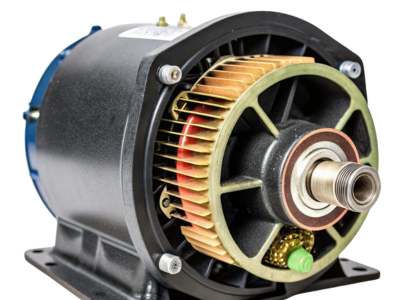
Listen for Problems with the Fan Motor
The fan motor is the part of your furnace that pushes warm air through the vents into your rooms. When it starts to fail, it usually makes noise. A healthy furnace makes a quiet humming sound, but a motor in trouble makes different noises.
Turn up your thermostat to make the furnace start, and just listen. Do you hear any of these sounds?
- A Loud Humming or Buzzing: This often means the motor is getting power but can't turn. It might be stuck.
- Grinding or Squealing: These are classic sounds of worn-out parts inside the motor. The motor is fighting just to spin, which makes it use way more electricity and trip the breaker.
- A Loud Clank or Thud: If you hear a loud bang when the furnace tries to start, that’s a bad sign. It often points to a serious problem inside.
These noises are your furnace's way of asking for help. A failing fan motor is a common reason for a tripping breaker because as it works harder to run, its need for power goes way up.
Pay Close Attention to Any Strange Noises Coming from Your Furnace
A motor that’s grinding or humming loudly is a big red flag. It’s working too hard, and that extra strain is likely what's causing the breaker to trip.
Look for Signs of Blocked Airflow
You've already checked for a dirty filter and blocked vents, but a clog could be hiding deeper in the system. Your air ducts are a large network, and a blockage anywhere can stop air from getting through. This can cause the furnace to get too hot and trip the breaker.
Again, you don't need any special tools for this. Just use your nose. Do you smell a faint burning or dusty smell coming from the vents when the heat is on? That's often the smell of dust burning off parts that are too hot. It's a clear sign that air isn't moving through the furnace correctly.
The goal here is to collect as much information as you can. Knowing what you've seen, heard, and smelled can help a technician figure out the problem much faster. If you need more pointers, our guide to troubleshooting common HVAC problems has some great tips.
When you call for service, being able to say, "The breaker trips, and I've been hearing a grinding noise," helps a technician know where to look before they even arrive.
Looking for Possible Electrical Issues
So, you’ve checked the usual furnace problems, but that breaker still trips. What’s going on? At this point, the problem might not be with your furnace at all. When a furnace keeps tripping the breaker, the cause can often be the home's electrical system.
Let's be very clear: this part is about looking for clues, not being an electrician. The goal is to spot warning signs from a safe distance so you can give a professional the right information. Please do not try to fix these things yourself—electricity is not a DIY project.
Is It the Furnace or the Wiring?
It can be hard to tell where the problem is. Is your furnace broken, or is something wrong with your home's wiring? Here’s a simple way to think about the signs you might be seeing.| Symptom | Likely a Furnace Issue If... | Likely an Electrical Issue If... |
|---|---|---|
| Breaker Trips Right Away | ...it happens the moment the furnace tries to turn on. | ...the breaker feels warm or looks burnt. Other lights or outlets on that circuit also have problems. |
| Trips Sometimes | ...it only happens when the furnace runs for a long time or the filter is very dirty. | ...it seems random and not related to the furnace. Other big appliances also trip that breaker. |
| Strange Smells | ...you smell something dusty or burning the first few times you use the heat for the season. | ...you smell a sharp, "fishy," or plastic smell near the breaker box or outlets. |
| Odd Noises | ...you hear mechanical grinding, squealing, or banging from the furnace itself. | ...you hear a buzzing, humming, or crackling sound coming from the circuit breaker box. |
A Weak or Bad Circuit Breaker
Circuit breakers are the heroes of your electrical panel, but they don't last forever. Like any switch, they can wear out, especially after tripping many times. A weak breaker can become too sensitive. It might turn off even when there isn't a real electrical problem.
If the breaker for your furnace feels warm to the touch (use the back of your hand to check safely) or if the switch feels loose when you reset it, you might have found the problem. This is a common issue, especially in older homes.
Signs of Loose Wires
Another possible cause is a loose wire somewhere between the breaker panel and the furnace. Over the years, small vibrations can make wires come loose. A loose wire is a serious danger because it can create sparks that get very hot and can easily start a fire.A Dangerous Smell
One of the biggest warning signs of a dangerous electrical problem is a sharp, "fishy" smell coming from an outlet or the breaker panel. That's the smell of melting plastic or burning wires. It means you need to call an electrician right away.Look for other signs, too:
- Burnt marks or dark spots around the breaker or on the panel cover.
- A sizzling or buzzing sound coming from inside the breaker box.
Any of these signs point to a serious problem that needs a licensed electrician, period. This is why safety devices are so important. You can read more about the importance of AFCI and GFCI protection in stopping these kinds of electrical dangers.
Finally, remember that your furnace uses a lot of power. It needs its own dedicated circuit. If you have other big appliances—like a space heater or a large TV—plugged into the same circuit, you might just have a simple overload. Try unplugging everything else on that circuit and see if that fixes the problem.
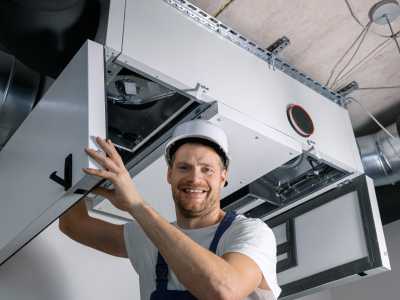
Know When to Call a Professional for Help
Look, it's great for homeowners to figure things out. But when it comes to your furnace, you have to know when to stop. Some problems are just too risky for a DIY fix. Pushing your luck can be dangerous for you, your family, and your home.
Working with complex electrical wires or furnace parts without the right training is a bad idea. It can lead to serious injury or even start a fire. A professional has the right tools and years of training to handle these systems safely.
Clear Signs You Need an Expert
If you see any of the following problems, it's time to stop what you're doing and call a pro. These are serious warning signs of bigger, possibly dangerous issues.
These are the things you should never ignore:
- You Smell Gas: A rotten egg smell is the classic sign of a natural gas leak. Don't touch any light switches. Get everyone out of the house right away, and call your gas company from a safe place outside.
- The Breaker Trips Instantly: You flip the breaker back on, and it immediately snaps off again. This is a classic sign of a short circuit, which is a major fire hazard
- You See Smoke or Scorch Marks: This is an emergency. If you see smoke coming from your vents or find black marks on or around your furnace or electrical panel, shut everything down.
- Loud Metal Noises: Any sudden banging or grinding is a bad sign. It often means a serious part has broken inside the motor. Running it will only cause more damage.
Think of It This Way
If a breaker trips the second you reset it, don't keep trying. That's your home's emergency stop button. A breaker that trips right away means there's a dangerous problem that needs an expert.
Making the Call to a Technician
When you decide to call for help, you can make the whole process easier by being prepared. A little bit of good information helps a technician figure out the problem quickly.
Before they arrive, take a minute to write down what you've noticed. This info is very helpful to a service tech.
What to Tell the HVAC Pro:
- Describe the Problem: Start by saying, "My furnace keeps tripping the circuit breaker."
- Mention Your Checks: Let them know what you've already done. Tell them you put in a new air filter and made sure all the vents are open.
- Share What You Noticed: Did you see anything else? Any strange noises like humming or grinding before it shut off? Did you smell anything odd?
- Tell Them How Often It Happens: Does the breaker trip right away, or does the furnace run for a few minutes first?
Giving the technician these details helps them start with a good idea of what to look for. It makes the service call faster for both of you.
Still Have Questions About a Tripping Furnace Breaker?
Even after you've looked around, it’s normal to still have questions when your furnace keeps tripping the breaker. It's easy to feel stressed when dealing with heating and electrical problems. Let's go over some of the most common questions we hear from homeowners.
Our technicians hear these same questions all the time, so let's clear them up.
Can a Bad Thermostat Cause a Breaker to Trip?
It’s not the first thing we check, but yes, it’s possible. A bad thermostat with old or damaged wiring can send the wrong signals to the furnace. This can make it turn on and off too quickly, which can use too much power and trip the breaker.
More often, though, a bad thermostat just won't turn the heat on or off when it should. If you’ve already checked your air filter and vents, a bad thermostat is worth mentioning when you call a pro.
How Much Does It Cost to Fix This Problem?
This is a big question, and the honest answer is: it depends on what’s causing the problem. The cost to fix a furnace that keeps tripping its breaker can be very different depending on the issue.
Here’s a rough idea of what you might expect:
- A Simple Fix: If the problem is just a dirty air filter, you’re looking at $10 to $30 for a new one. This is the best and easiest fix.
- An Electrical Repair: If the circuit breaker itself is bad, an electrician will charge for their time plus the cost of the part. This usually costs between $150 and $300.
- A Major Part Replacement: If the fan motor is broken, that’s a bigger repair. Depending on your furnace, this can cost anywhere from $400 to over $1,500.
Always ask for a price estimate from the technician before they start any work. Nobody likes surprise bills.
Is It Safe to Keep Resetting the Breaker?
No, it's not. You should never keep resetting a breaker that trips over and over. That little switch is a key safety device in your home. It's designed to cut power and prevent a fire.
Breaker Tripping More Than Once?
If the breaker trips more than once, it's telling you there’s a real and possibly dangerous problem. Flipping it back on again and again can damage your furnace and greatly increases the risk of a fire.Think of it like the emergency brake in your car. If you have to keep pulling it, you need to fix the car, not just keep trying to drive.
Does an Old Furnace Trip the Breaker More Often?
Yes, an older furnace is much more likely to have problems that cause a breaker to trip. After years of use, parts like the fan motor and wires just wear out.
An old motor often has to use more electricity to do the same job, which can overload the circuit. In the same way, wire covers can get old and crack over time, creating a risk for a short circuit. While age itself isn't the direct cause, it makes all these other problems more likely to happen.
Let the Engle Services Experts Take a Look
If you've tried the DIY fixes and are still dealing with a stubborn breaker, it's time to let the experts at Engle Services LLC take a look. Servicing central Alabama and North West Florida, Our certified technicians can safely find the real problem and get your heat running again. Don't risk your family's comfort and safety—schedule your service with us today!
Lewis Engle
CEO Engle Services LLC
Engle Services offers Furance Repair and Installation and Electrical Service in Sylacauga, Talladega, Birmingham, Shelby County (Hoover, Chelsea), Alabaster, Pell City, Dadeville, Wetumpka, Montgomery, Fort Walton Beach, FL
 Ready to schedule with our team of HVAC Technicians, Electricians, and Plumbers?
Schedule an appointment online or give us a call at (855) GET-ENGLE
Ready to schedule with our team of HVAC Technicians, Electricians, and Plumbers?
Schedule an appointment online or give us a call at (855) GET-ENGLE
